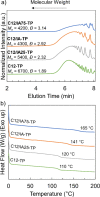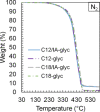Itaconic Acid as a Comonomer in Betulin-Based Thermosets via Sequential and Bulk Preparation
- PMID: 37771764
- PMCID: PMC10526528
- DOI: 10.1021/acssuschemeng.3c04178
Itaconic Acid as a Comonomer in Betulin-Based Thermosets via Sequential and Bulk Preparation
Abstract
The inherent chemical functionalities of biobased monomers enable the production of renewably sourced polymers that further advance sustainable manufacturing. Itaconic acid (IA) is a nontoxic, commercially produced biobased monomer that can undergo both UV and thermal curing. Betulin is a biocompatible, structurally complex diol derived from birch tree bark that has been recently studied for materials with diverse applications. Here, betulin, IA, and biobased linear diacids, 1,12-dodecanedioic acid (C12) and 1,18-octadecanedioic acid (C18), were used to prepare thermosets using sequential and bulk curing methods. Thermoplastic polyester precursors were synthesized and formulated into polyester-methacrylate (PM) resins to produce sequential UV-curable thermosets. Bulk-cured polyester thermosets were prepared using a one-pot, solventless melt polycondensation using glycerol as a cross-linker. The structure-property relationships of the thermoplastic polyester precursors, sequentially prepared PM thermosets, and bulk-cured polyester thermosets were evaluated with varying IA content. Both types of thermosets exhibited higher storage moduli, Tgs, and thermal stabilities with greater IA comonomer content. These results demonstrate the viability of using IA as a comonomer to produce betulin-based thermosets each with tunable properties, expanding the scope of their applications and use in polymeric materials.
© 2023 The Authors. Published by American Chemical Society.
Conflict of interest statement
The authors declare no competing financial interest.
Figures






References
-
- Highlights: An Economic Impact Analysis of the U.S. Biobased Products Industry; U.S. Department of Agriculture: usda.gov, 2021.
-
- Cheng H. N.; Gross R. A.; Smith P. B., Green Polymer Chemistry: Pipelines Toward New Products and Processes. In Green Polymer Chemistry: New Products, Processes, and Applications; Cheng H. N.; Gross R. A., Smith P. B., Ed.; American Chemical Society: 2018; Vol. 1310, pp 1–11.
-
- Spierling S.; Venkatachalam V.; Mudersbach M.; Becker N.; Herrmann C.; Endres H.-J. End-of-Life Options for Bio-Based Plastics in a Circular Economy—Status Quo and Potential from a Life Cycle Assessment Perspective. Resources 2020, 9 (7), 90.10.3390/resources9070090. - DOI
LinkOut - more resources
Full Text Sources
